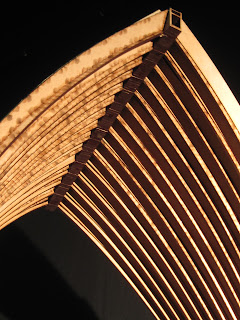Wednesday, September 29, 2010
detail and poetry
1. As the technique of detailing changed from the hands of the craftsman to the tools of the architect, how has the resulting construction of details changed? Explain in terms of scale, material and cost.
The technique of detailing has definitely changed; especially in the past couple of years were technology plays a big role in our future. Before, craftsman would have a closer relationship with the material and pay extra attention to detail. On the other hand, architects have more contact with the use of tools and technology. During the industrial revolution, people complained about how the detailing technique was lost by the use of machinery. I think people still depend more on the use of technology and that’s why that personal effect made by hands of a craftsman is lost.
2. How does "geometrical relationship" of individual details provide an understanding of the whole building if "indirect vision" localizes the viewer and "habit determines to a large extent even optical reception"?
The geometrical relationship simply gives you a better understanding of the building
3. Carlo Scarp's details are a "result of an intellectual game" where the Open City buildings are constructed from an act of poetry. Describe what role the detail plays to "tell-the-tale" in each of these environments.
4. Pendleton-Jullian writes about the Open City as emerging from and being in the landscape. Does allowing landscape to initiate "the configuration of territory and space" challenge Western building notions, and how so?
5. Describe some detail conditions of the Open City that convey "lightness" as Pendleton-Jullian refers to.
Tuesday, September 28, 2010
Wednesday, September 22, 2010
Material List
Qty. Item Price
1 1/2" Birch Plywood 31.77
3 Barrel Bolt 8.67
1 #8 1/2" Screws 3.77
10 1/2" Cut Washers 1.90
1 5/16" Wood Dowels 2.97
4 1/2" Hex Nuts 3.92
2 1/2" Wing Nuts 1.86
2 1/4" Wing Nuts 1.86
2 1/2" Threaded Rod 8.94
2 1/4" Threaded Rod 1/2 2.28
2 Casters 9.92
1 1/2" Threaded Rod 1/2 5.96
83.82
Monday, September 20, 2010
Reading Tectonics
The readings refer to tectonics in a variety of settings; tectonic/stereotomic, tectonic/atectonic, topos/typos/tectonic, representation/ontological, rhythm, corporeal metaphor, ethnography, and technology. Briefly define each term and provide an architectural example that embodies the condition.
Tectonics/stereotomic: refers to a more frame driven and to lighter materials, stereotomic Refers to solid, more mass and earth.
Tectonic/atectonic: complete opposites, atectonic is the form or structure elements that are hidden
Topos/typos/tectonic: this means site, type or style, and structure
Corporal metaphor: physical body thinks of space without mind
Representation/ontological: refers to the symbolic and technical relationship of the structure
Rhythm: the creation of movement by a set of repeating elements
Ethnography: talks about the association of human culture in architecture
Technology: talks about the development of new applications, and how it alters space and architecture
Kenneth Frampton writes that this study of tectonics "seeks to mediate and enrich the priority given to space", what is a dominant trend in Western architecture of today and how does tectonics relate to this trend?
Kenneth Frampton writes that this study of tectonics "seeks to mediate and enrich the priority given to space", what is a dominant trend in Western architecture of today and how does tectonics relate to this trend?
The most popular trend found in Western architecture was just building in order to meet the requirements of the client. Unlike tectonics that focuses on the structure or atectonics, the hidden structure, I believe this relationship is lost.
"Greek in origin, the term tectonic derives from the work tekton, signifying carpenter or builder". How has the the impact of Albert Einstein's theory of relativity and other space-time models altered tectonic etymology?
"Greek in origin, the term tectonic derives from the work tekton, signifying carpenter or builder". How has the the impact of Albert Einstein's theory of relativity and other space-time models altered tectonic etymology?
Albert Einstein’s theory of relativity with several other discoveries made a huge impact in human society, and it changed the meaning of tectonic etymology. Now, tectonic is not just referring to the carpenter, but rather someone who is able to make anything, someone that understands the space and its relationship.
Vittorio Gregotti states in 1983, "(t)he worst enemy of modern architecture is the idea of space considered solely in terms of its economic and technical exigencies indifferent to the ideas of the site". If the intention of site is to situate human in the cosmos, how then does site infer from a contemporary landscape that has been graded, conditioned, tamed, treated, sculpted, mapped, engineered, essentially re-created by humans?
Vittorio Gregotti statements talks about how modern architecture is turning into a big threat to our natural landscapes because we can mold the environment to fit our needs instead of just adapting to it. The idea of situating human in the cosmos refers to adapting in the environment.
Is architectural tectonics applicable or relevant in a world of global mobilization? State and explain your position.
Is architectural tectonics applicable or relevant in a world of global mobilization? State and explain your position.
I believe that tectonics is relevant in a world of global mobilization. It creates a relationship with the materials and a better understanding of the structural system. New technology discoveries also help the advancement of architectural tectonics.
Saturday, September 4, 2010
Subscribe to:
Comments (Atom)







